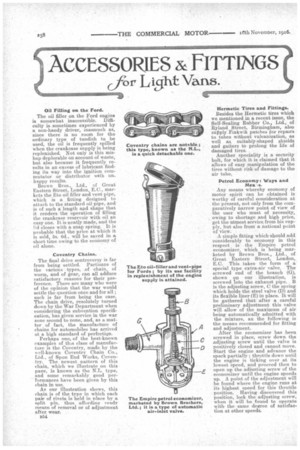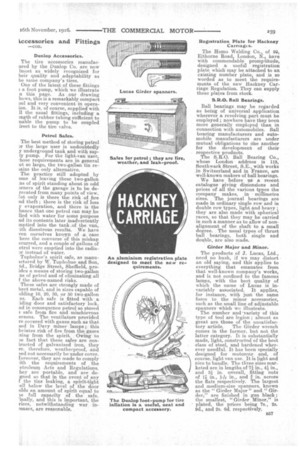ACCESSORIES & FITTINGS
Page 18

Page 19

If you've noticed an error in this article please click here to report it so we can fix it.
for Light Vans.
Oil Filling on the Ford.
The oil filler on the Ford engine is somewhat inaccessible. Difficulty is sometimes experienced by a non-handy driver, inasmuch as, since there is no room for the ordinary type of tundish to be used, the oil is frequently spilled when the crankcase supply is being replenished. Not only is this mishap deplorable on account of waste, but also because it frequently results in an excess of lubricant finding its way into the ignition commutator or distributor with unhappy results,
Brown Bros., Ltd., of Great Eastern Street, London, E.C., markets the Eto oil filler and vent pipe, which is a , fitting designed to attach to the standard oil pipe, and is of such a length and shape that it renders the operation of filling the crankcase reservoir with oil an easy one. It is neatly made, and the l:d closes with a snap spring. It is probable that the price at which it is sold, 5s. 6c1., will be saved in a short time owing to the economy of oil alone.
Coventry Chains.
The final drive eontroversy is far from being settled. Partisans of the various types, of chain, of worm, and of gear, can all adduce satisfactory reasons for their preference. There are many who were of the opinion that the war would settle the question once and for all ; such is far from being the case. The chain drive, resolutely turned down by the War Department when considering the subvention specification, has given service in the war zone second to none, and, as a matter of fact, the manufacture of chains for automobiles has arrived at a high standard of perfectien. Perhaps one of the best-known examples of this class of manufaeture is the Coventry, made by the well-known Coventry Chain Co., Ltd., of Soon End Works, Coventry. The newest pattern of this chain, which we illustrate on this page, is known as the N.L. type, and some remarkably good performances have been given by this chain in use.
As our illustration shows, this chain is of the type in which each pair of rivets is held in place by a split pin, thus aftordinz ready means of removal or of adjustment after wear.
B54 Hermetic Tires and Fittings.
Besides the Hermetic tires which we mentioned in a recent issue, the Self-Sealing Rubber Co., Ltd., of Ryland Street, Birmingham, also supply Fialtwik patches for repairs to tubes without vulcanization, as well as, suitably-shaped shields and gaiters to prolong the life of damaged tires.
Another speciality is a security bolt, for which it is claimed that it allows of easy manipulation of the tires without risk of damage to the air tube.
Petrol Economy : Ways and Men s. Any means whereby economy of motor spirit can be obtained is worthy of careful consideration at
• the present, not only from the comparatively narrow point of view of the user who must of necessity, owing to shortage and high price, get the utmost service from his supply, but also from a national point of view.
A simple fitting which should add considerably to economy in this respect is the Empire petrol economizer, which is being marketed by Brown Bros., Ltd., of Great Eastern Street, London, E.C. This takes the form of a special type extra-air valve. The screwed end of the branch (G), shown on our illustration, is screwed into the exhaust pipe. B is the adjusting screw, C the spring which holds the steel valve (D) and its flexible liner (E) in place. It will be *athered that after a careful preliminary adjustment this valve will allow of the maximum of air being automatically admitted with the mixture, an the following is the means recommended for fitting and adjustment. After the economizer has been screwed in place, screw down the adjusting screw until the valve is positively closed and cannot move. Start the engine and advance the spark partially' throttle down until the engine is ticking over at its lowest speed, and proceed then to open up the adjusting screw of the economizer until the engine speeds up. A point of the adjiistment will be found where the engine runs at its highest speed for this throttle position. Having discovered this position, lock the adjusting screw, when it will be found to operate withthe same degree of satisfaction at other speeds. Dunlop Accessories.
The tire accessories manufacured by the Dunlop Co. are now lmost as widely recognized for heir quality and adaptability as he same company's tires.
One of the latest of these fittings i a foot pump, which we illustrate n this page. As our drawing hows, this is a remarkably compact ool and very convenient in operaion. It is, of course, supplied with 11 the usual fittings, including a mgth of rubber tubing sufficient to nable the pump to be coupled irect to the tire valve.
Petrol Safes.
The best method of storing petrol ir the large user is undoubtedly y underground tank and with suply pump. For the light-van user, lose requirements are in general ot so large, the two-gallon tin retains the only alternative.
The practice still adopted by owe of leaving these two-gallon as of spirit standing about in odd Drners of the garage is to be derecated from many points of view. lot only is there the risk of fire nd theft ; there is the risk of loss y evaporation, and there is the hance that one petrol can may be lied with water for some purpose ad its contents later inadvertently raptied into the tank of the van, ith disastrous results. We have run ourselves known of a case there the converse of this mishap ccurred, and a couple of gallons of etrol were emptied into the radiair instead of water.
Tupholme's spirit safe, as manu"ctured by W. Tupholme and Son, td., Bridge Street, Sheffield, proides a means of storing two-gallon ns of petrol and of ehminatmg all f the above-named risks.
These safes are strongly made of hect metal, and in sizes capable of olding 10. 20, :30, or 50 two-gallon ns. Each safe is fitted with a iding door and satisfactory lock, nd in consequence petrol so stored 3safe from fire and mischievous
ersons. The ventilators provided re covered with gauze such as that sed in Davy miner lamps ; this bviates risk of fire from the gases [sing from the spirit. Owing to
le fact that these safes are contructed of galvanized iron, they re. therefore, weatherproof, and sed not necessarily be under cover.
foreover, they are made to comply ith the requirements of the etroleum Acts and Regulations. hey are portable, and are degned so that in the event of any f the tins leaking, a spirit-tight 'ell below the level of the door olds an amount of spirit equal to le full capacity of the safe. bay, and this is important, the rices, notwithstanding war ineases, are reasonable.
Registratio n Plate for Hackney Carriages.
The Homo Welding Co., of 93, Elthorne Road, London, Isl., have with commendable promptitude, designed a useful registration plate which may be attached to an existing number plate and is so worded as to meet the requirements of the new Hackney Carriage Regulation. They can supply these plates from stock.
S.R.O. Ball Bearings.
Ball bearings may be regarded as being of universal application wherever a revolving part must be employed ; nowhere have they been more generally employed than in connection with automobiles. Ball bearing manufacturers and automobile manufacturers are under mutual obligations to dile another for the development of their respective products.
The S.R.O. Ball Bearing Co., whose London address is 115, Southwark Street, S.E.' with works in Switzerland and in France, are well-known makers of ball bearings.
We have before us a recent catalogue giving dimensions and prices of all the various types the company makes, in millimetre sizes. The journal bearings are made in ordinary single row and in double row types, light and heavy; they are also made with spherica races, so that they may be carried in such a manner as to allow of nonalignment of the shaft to a small degree. The usual types of thrust ball bearings, both single and double, are also made.
Girder Major and Minor.
The products of J. Lucas, Ltd., need no bush, if we may distort an old saying, and this applies to everything that emanates from that well-known company's works, and is not confined to the famous lamps, with the best quality of which the name of Lucas is invariably associated. It applies, for instance, with just the same force to the minor accessories, such as the small line of adjustable spanners which we illustrate.
The number and varietyof this type of tool are legion ; almost as great are those of the unsatisfac
tory article. The Girder wrench comes in the former, but not the latter category. It is substantially made, light, constructed of the best class of steel, and hardened wherever needful. It has been specially designed for motorcar and, of course, light van use. It. is light and nice to handle. The three sizes marketed are in lengths of 71 in., 41 in., and 3.1,in. overall, fitting nuts of l in., ir in., and it in. across the fiats respectively. The largest and medium-size spanners, known as the "Girder Major" and "Girder," are finished in gun black ; the smallest, "Girder Minor," is plated, the prices being 7s., 2s. 9d., and 2s. 6d. respectively.






















